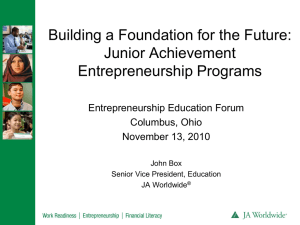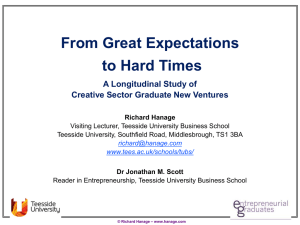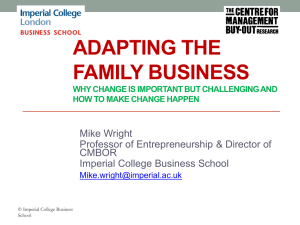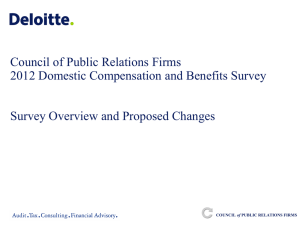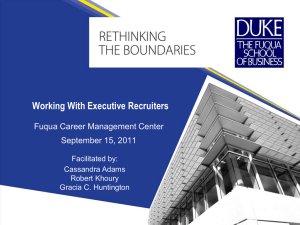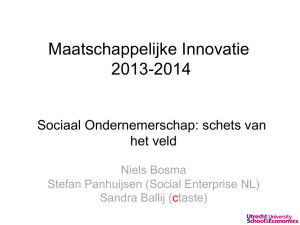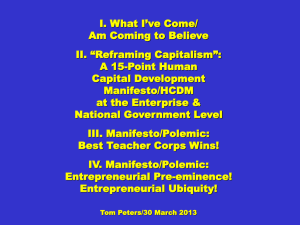You Have a Very Bad Hotel - National Association for Community
advertisement
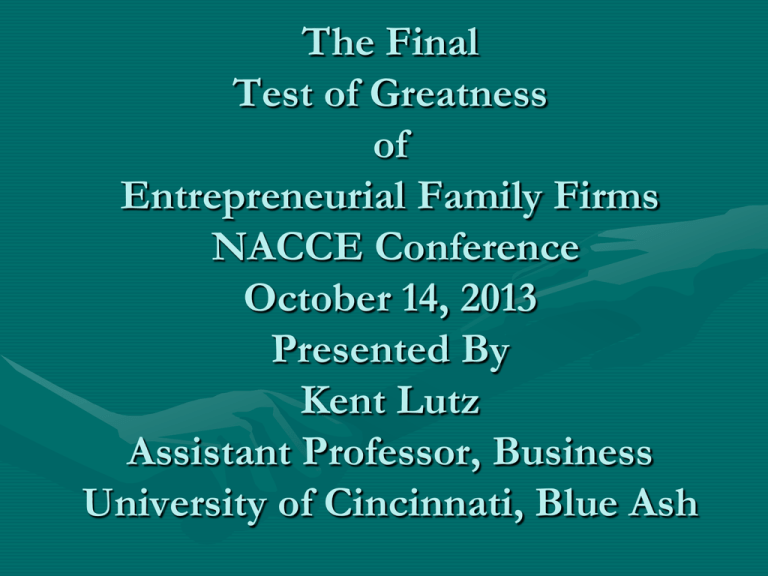
The Final Test of Greatness of Entrepreneurial Family Firms NACCE Conference October 14, 2013 Presented By Kent Lutz Assistant Professor, Business University of Cincinnati, Blue Ash Agenda for Presentation •Brief Introduction and Background of Entrepreneurial Family Firms •Some Entrepreneurial Family Firm Statistics •Obstacles to Entrepreneurial Family Firm Succession Planning •Case Study on an Entrepreneurial Family Firm •What Can Your College do to Reach Out to Family Firms Statistics 65-85% Of all Entrepreneurial Businesses Worldwide are Family Owned 12 Million Entrepreneurial Family Firms in the U.S. 70% of All Employees Work for Family Firms 50% of GNP comes from Entrepreneurial Family Owned Firms 15 Trillion in Assets will be Transferred Over the Next 20 Years 43% of Entrepreneurial Family Firms will Change Hands Within 5 Years 70% of Senior Generation in Family Firms are Committed to Continuing Family Ownership 70% of Younger Generation Hope to Take Ownership 56% of Entrepreneurial Family Firms Have no Formal Succession Plan 40% of Owners of the Fastest Growing Companies in U.S. have No Estate Plan Less Than 13% of Family Owned Companies Make it Successfully to the Third Generation Of all Law Suits Settled in Entrepreneurial Family Firms They Involve the Family Members of the Company. Most Common Entrepreneurial Family Firm Mistakes Inability to communicate effectively. Not holding family members accountable. Family firms do not acknowledge the normal consequences of passing generations – that is the glue that holds the family together. Lack of formal business practices – no strategic plan. No family charter – no family mission statement No family council – no Board of Advisors No formal plan for hiring and firing – no compensation plan with performance, position descriptions, and sweat equity participation. No formal way to resolve conflict and differences – no negotiation skills. No way to resolve differences – distinction between takers and givers. Not distinguishing between a entrepreneurial family firm and a business family. No formal family retreat organized to enhance communication issues and provide a forum for all family members to participate. No formal estate plan and wealth transfer strategy. No formal succession plan and/or exit strategy. No strategy for leadership development of successors. No charitable or philanthropic strategy to compliment estate planning. No buy/sell agreements. Defining Succession Planning A multidisciplinary process, both comprehensive and strategic in approach, that assists closely-held entrepreneurial businesses structure an orderly transition of management and ownership. Includes the following planning modules: Goal Articulation Business Strategy Assessment Management Talent Assessment Family Information and Communication Corporate Finance Estate and Gift Planning Life Insurance Analysis Investment Advisory Services Shareholder Agreements Disability Planning Corporate Structuring Current Business Valuation Compensation Planning Stock Transfer Techniques Family Offices The Why’s of a Good Succession Plan To create something significant and of lasting value – a sort of immortality. The opportunity for the next generation to manage capital, be a community leader, have a sense of control over one’s destiny. It enhances the value of an entrepreneurial business by retaining the most talented potential successors. Creates entrepreneurial energy by the next generation to take the business to another level. Helps eliminate ambiguity – that is you must face the fact of mortality, forces choices to be made, and power, prestige, and position must be met head on. Helps to openly discuss sensitive issues such as retirement and death, as that tends to be difficult for most people to address – dodging the issues protects business owners from making tough decisions. Helps retain key people from departing the company. Represents the cornerstone of stewardship. Silence does not prevent family members from forming their own opinions about their private expectations regarding dividends, compensation, family participation, and rights to ownership – worse case could lead to litigation and destroy a lifetime of building. You plan because you don’t want the lawyers settling your family’s future. You must separate your personal identity from the business – you must think in terms of what’s the value of the business apart from me, how do I move functions to other people, how can I pass on my skills and business relationships It is important to “Let Go” and find a new focus for energies that help build the business and have a clean and healthy break with the business. Founders need to sustain their standard of living indefinitely without relying on their children or business. To avoid shareholder conflict where passive shareholders may see the business as a birthright and resent the pay and perks of family members who are working in the business, and active shareholders resent passive owner’s demands for dividends and liquidity. Helps form shareholder meetings and family councils to become vehicles for finding consensus and defining proper roles for passive holders. 1. 2. 3. 4. 5. Ten Steps in Succession Planning For Entrepreneurial Family Firms The Final Test of Greatness Establish a Family Participation Policy Provide Excellent Work experience – and No Succession Expectations Commit to Family Firm Continuity via Family Mission Statement Design a Leadership Development Plan Have an Active Board of Directors Containing Experienced Non-Family Business Leaders, and use Your Board 6. 7. 8. 9. Clarify Business Strategic Plan Fund Senior Generation Personal Financial Security Identify Successor or Successor Selection Process Empower Organizational Succession Transition Team 10. Complete Transfer of Ownership Control Succession Planning “The Final Test of Greatness” “The Cornerstone of Stewardship" “The Final Test of Greatness of a CEO is how well he/she chooses a successor and whether he/she can step aside and let the successor run the company.” “The Attitude of the Business Owner is the single most important factor in any succession.” “A well planned succession is more like the graceful exchange of the baton between runners in a relay race. The handoff is almost undetectable to the spectator, yet it requires stamina, discipline, conditioning and share goals.” Peter Drucker Suddenly in Charge Practical things for the “CEO” to do. What to do now to prepare someone to carry on. Put a number on your financial position. What’s your company really worth? After debt, if there is any? What Personal Benefits – Cars, Property, Memberships, Health Benefits – Would have to come out of personal funds without the Company? What’s the overall health of your business? Is it new and growing, or solid and established, or a last hold out in a mature industry? If something happened to you, would someone step in and snap up the Company? Why or why not? How will your spouse continue to be paid by the Company in your absence? Does the Company support other family members, and should they continue to be paid in your absence and under what terms? If you were absent from the picture, are there adverse covenants in your bank loans – due to death clauses, etc? Who will make up your carry-on team? Who should your spouse rely on – both inside and outside the Company? Are there any business associates or industry contacts who could advise your spouse? Whose judgment should prevail in cases of disputes? Make sure your successor knows the strengths and weaknesses you’ve recognized in your close associates. In the first few days of your absence, your successor will have to address your employees and customers. What kind of questions will be asked? How will vendors and lenders react? Will anyone call in a state of alarm, and what will they want to know and have done? In the months that follow your departure, your successor will have to deal with ownership, employees, customers, operations, ticking time bombs and future vision. Who owns the business – Just you and your spouse, or others as well? How much authority do they have? Are there any buy-sell agreements in place? Any warrants or stock options outstanding? Any promises of ownership or participation? Where are the key documents, and who is the attorney who handles these matters? Who are your key employees? Are there any employee contracts? Any promises made regarding promotions or bonuses? Who should be retained at almost any cost? What kind of incentives should be offered to key people? Who should be promoted and at what level? Who are your key customers, and how will you keep them happy? Who are most important for the long term health of the business? What about marginally profitable customers – should they be maintained – why or why not? How to deal with customers strictly handled by you over the years. How does the company secure new customers? What sales and marketing activities must be maintained without lapse? What exactly does the Company do, and who manages day-to-day production activities and the office? Who manages the communication systems and networks? What must be done to keep it running smoothly? What key measures do you use to measure productivity and efficiency? Are there any capital expenditures on the horizon or any equipment delivery expected? Are they any plans to close down anything? What is the financial picture of the Company? Who is the accountant who knows the business the best? Where are all the tax records? Is there enough cash on hand? Do you have a line of credit? Are all receivables collectable? What could you sell your business for today? Who would buy it? Would your employees or partners want to take over? Are there any issues in the background that might suddenly come to light and cause trouble? Any lawsuits or compliance issues? Environmental liabilities? Insurance losses? What would be the downside here? What is your real attitude toward the business? Is it your grand passion, and does it have a strong mission yet to be achieved? Or is it primarily a strong source of cash flow? Does your family know how you feel and what your true wishes are, or are they included to preserve the business intact to honor you? Opportunities For Community Colleges To Reach Out To Entrepreneurial Family Firms And Make Them Part Of Your Entrepreneurial Program Create a Luncheon Series Focusing on Family Firm Needs Create a Next Generation Program Dealing With Succession Create a Newsletter Focusing on Family Firms Seek Membership and Offer Value Seek Community Partners Seek a Benefactor Create an Advisory Board of Family Firms And Advisors to Family Firms Create an Annual Awards Event Create a Podcast/Radio Program/Website/Blog Partner With a Local Educational TV Station Hire a Full Time Entrepreneurial Family Firm Director With A Faculty Member as a Bridge to The College The Use of Mentors Partner With Local Chamber(s)/SCORE/SBA/ Local Economic Development Agency Utilize Various Assessment Tools to Evaluate Family Firm Issues Possible Sponsors-Banks/Law Firms/CPA’s/ Insurance Companies/Investment Firms Consider Creating a Separate 501c3 Engaging Entrepreneurial Family Firms Could Very Easily Enhance Financial Support of Your College Presenting The Lighter Side of Entrepreneurial Family Businesses 10 Most Prevalent Obstacles to Entrepreneurial Family Firm Succession Planning 10. Poor Expression of Feelings and Wants. People are afraid to be vulnerable, which leads to ineffective communication; we are taught not to express our feelings; we lack the confidence to talk about emotional issues. Solution: Get some Communication Training 9. Differences are Often Seen as Liabilities Rather than Assets Differences are the key to an active and exciting life; sometimes differences are interpreted a “you don’t love me” or “you don’t care;” differences are not brought up because of the fear of disrupting family harmony; the failure to bring up differences often results in the very problem you are trying to avoid. Solution: Myers-Briggs testing helps understand how we are wired 8. Indirect Communication: A very insidious problem where family members talk to other family members who are directly involved in the business; this creates a triangle that destroys family relationships. Solution: Family Meetings - All Inclusive. 7. Entitlement: Usually seen as a younger generation issue; using the family name and influence only to take advantage over other employees is a formula for disaster; it’s a senior generation issue as well, as the senior generation uses it to feel that they have the primary and only responsibility for leadership. Solution: Communicate a common family business vision and work together to achieve it. 6. Scarcity: Manifests itself around the discussion of money, roles, and power; the lack of expression of appreciation, recognition, and love is the underlying problem with emotional scarcity. Solution: Family members must talk directly about what they expect from each other and family members must empower each other to achieve their fullest potential. 5. History: The full history of a family is very important to understand and embrace. Each family has difficulties but must celebrate the history in some way rather than sweeping it under the rug or ignoring it. Solution: Families must learn from their history. “Life can only be understood backwards, but it must be lived forwards.” 4. Other – Oriented Regarding Change: Change is one of the most difficult things in life – even when it’s positive it is difficult; when we expect others to change only and not ourselves, it is a formula for disaster. Classic Example – Overlapping circles – founder and father (business circle very big, family circle very small); Wife and Mother (family circle very big, business circle very small); Children’s circles are caught in the middle; often we blame each other and expect the other person to change. Solution: We must take self responsibility for what we successfully contribute, as well as, full responsibility for our contributions to the problem. 3. Control: Control is the Achilles Heel of most entrepreneurs; control is about change; the succession planning process can be viewed as treacherous to the senior generation members because they fear that their company is being taken from them and change is tough. Solution: Entrepreneurs are driven by their dreams, and since it’s very difficult to change or control entrepreneurs, it’s all abut helping them develop new dreams in relation to their family, business, communities, leisure time, and philanthropy. 2. Lack of Forgiveness: It’s impossible to work in a entrepreneurial family business without stepping on toes, and if families are unwilling to forgive transgressions, it can lead to disaster. Solution: May be to draw upon the family’s faith background. 1. Lack of Appreciation, Recognition and Love: Often the root of wanting to be recognized for the value and contribution one makes. There is an implicit assumption that we are appreciated, but it is seldom, if ever, actually expressed.. Solution: Talk about expectations in an emotional sense and learn how to express sincere and honest appreciation, recognition, and love. The emotional bottom line is just as important, if not more important, than the financial bottom line. Planning is the key, and addressing issues in a proactive way helps to achieve the success we are all seeking.. GENOGRAMS A genogram is a pictorial representation of family relationship across several generations. It can be a convenient organizing device to help you identify patterns or develop hypotheses about family functioning. Genograms can vary significantly and are only limited by your imagination. Most genograms include basic information about number of marriages, number of children of each marriage, birth order, and deaths. Some genograms also include information on disorders running in the family (e.g. alcoholism, depression) alliances, and living situations. Generally, males are identified on a genogram with a square, females with a circle. Deaths are indicated by an X through that individual’s marker. Spouses are connected with lines, separations and divorces indicated by slash lines running through the lines. Birth, marriage, divorce, and death dates may be indicated by the initial and date (i.e., b.89). Ages by numbers in the markers. Circles can include and indicate members outside the nuclear family living together. Cutoffs, alliances, enmeshments, and stressful relationships are indicated by the nature of lines connecting individuals. Alcoholism (or other relevant issues) are frequently indicated by filling in the bottom part of the individual’s marker. Key to Symbols Used in Genogram Male Female Marriage Death Male Death Female Children (Listed in birth order beginning on left with oldest) First Child (daughter) Twins Adoption Marital Separation Divorce or Cutoff Second Child (son) Unmarried Couple Very Close or Fused Immediate Household Distant Physical Emotional Illness Illness Female Male Stillbirth Miscarriage Husband W/ Several Wives Poor or Conflictual Fused and Conflictual Close This is a simple example of a family genogram. As you look at it, you may want to generate hypotheses about how this family functions. A variety of patterns and hypotheses (which are either confirmed or disconfirmed) can be generated for any family genogram and are limited only by your imagination. Works at Company Frank Mary 61 60 Barbara 35 M ’62 , D ‘90 Curt ? All Teens 39 Elizabeth Sally ? 37 12 6 35 M ‘90 Jack 39 D ‘O1 3 ?



